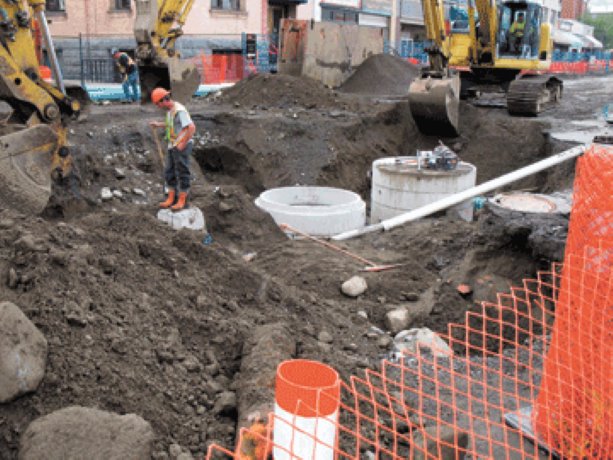If you’re already committed to a major road improvement project, it often makes logistical sense to perform sewer and watermain work at the same time. Of course, having to blast through solid bedrock – twice – adds complexity to the project.
That was the situation the city of Rossland, B.C. found itself in after accepting an offer from the Ministry of Transportation to fund a downtown paving project. The idea of replacing sewer and water infrastructure beneath the street soon followed.
The 60-year-old sewer system is being replaced both due to its condition and capacity, says Darrin Albo, manager of operations, city of Rossland. “We’ve had some major back-ups in some of the commercial buildings downtown, and when we did some camera inspection work, we realized the lines were in worse shape than we had originally thought.”
The city’s water infrastructure dates back even further, with some of the lines estimated at more than a century old.
Construction of the original sewer line required blasting down to 17 feet in some spots to create the proper incline for a gravity-fed sewer system.
“We can’t follow the original route for two reasons,” says Albo. “It’s difficult to simultaneously excavate and replace a sewer line that’s buried that deep. Also, highway closure rules dictate that we need to keep at least one lane open on the road at any time, but the existing sewer line is located in the centre of the right of way. Digging it up and replacing it would close both lanes at the same time.”
The solution was to realign the new sewer line and move it closer to one side of the road.
While some bedrock was expected, its exact location was unknown. Thorough core sampling couldn’t be conducted for fear of rupturing existing sewer and water lines with drills. Once the roadbed was opened, it became clear that contractors would have to blast through 240 linear feet of bedrock to accommodate new sewer, water and stormwater lines.
Contractor Meka Construction Services conducted an extensive pre-blast inspection of local buildings to document any pre-existing cracks or blemishes. The city then called on B & N Blasting Contractors Ltd. to remove the rock using explosive charges scheduled approximately three hours apart.
“The charges were placed in small holes, very close together, and the excavation was covered with rubber blast mats to damp the explosions,” says Albo. “Incredibly, the blasting wasn’t much of an issue downtown. We were more concerned with creating an adequate number of temporary parking spaces behind some of the businesses and accommodating pedestrians.”
Blasts were monitored by seismic equipment to measure the magnitude and volume of explosions, although Rossland mayor Greg Granstrom compared the effect of the controlled blasts to the shock of a logging truck hitting a pothole at 50 km/h. Shopping continued as usual a few minutes before and after each blast.
Regulations dictate that water lines may not occupy the same trench as a sewer line. Once the deep sewer trench had been completed, the contractor turned around and blasted a second trench for potable water between the sewer trench and the sidewalk, this time to five to six feet below the surface of the road.
“While we were blasting, we came across a lot of old infrastructure dating as far back as the 1800s,” says Albo. “That includes old water lines, some of which were live and some dead. At one point during an operation to remove rubble from the blasting we came across an underground crevice that some people thought might be an old mineshaft.”
While the crevice might have been excavated as a potential mine entrance, engineers determined that there was no shaft beyond it. The crevice was filled with five cubic metres of concrete.
“We hope to have the entire project finished and asphalt down on the roads by December 1st,” says Albo.



Recent Comments
comments for this post are closed